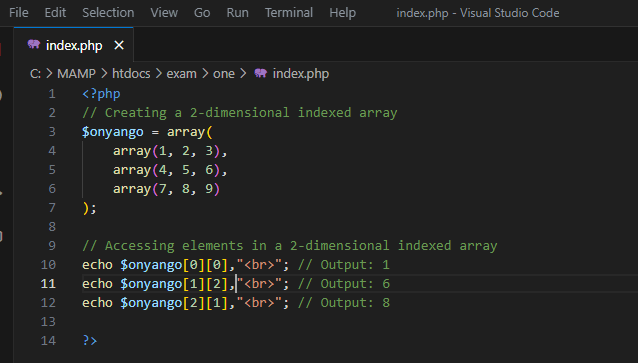Mastering Array Manipulation in PHP: A Comprehensive Guide

Introduction: Arrays are fundamental data structures in PHP, providing a versatile and powerful way to store, manipulate, and iterate over collections of data. Whether you’re building dynamic web applications, processing form submissions, or handling database results, understanding how to work with arrays in PHP is essential for any PHP developer. In this comprehensive guide, we’ll explore the myriad of functions and techniques available for working with arrays in PHP, covering everything from basic operations to advanced manipulation. By the end of this article, you’ll be proficient in harnessing the full potential of arrays to streamline your PHP development workflow.
- Introduction to Arrays in PHP: An array in PHP is an ordered map that stores a collection of elements, each identified by a unique key. PHP supports both indexed arrays (arrays with numeric keys) and associative arrays (arrays with string keys). Arrays in PHP are dynamic and flexible, allowing you to add, remove, and modify elements as needed. They serve as the foundation for storing and manipulating data in PHP applications.
- Creating Arrays: In PHP, you can create arrays using several methods. The most common way is to use array literals, which consist of a comma-separated list of elements enclosed in square brackets
[]. Here’s an example of creating an indexed array:
$colors = ["red", "green", "blue"];
You can also create associative arrays by specifying key-value pairs:
$person = ["name" => "John", "age" => 30, "city" => "New York"];
In this example, "name", "age", and "city" are keys, and "John", 30, and "New York" are corresponding values.
- Accessing Array Elements: You can access individual elements of an array using square bracket notation with the element’s key or index. For example:
echo $colors[0]; // Output: "red"
echo $person["name"]; // Output: "John"
You can also use loops to iterate over arrays and access each element:
foreach ($colors as $color) {
echo $color . " ";
}
// Output: "red green blue"
- Array Functions: PHP provides a wide range of built-in functions for manipulating arrays. Some of the most commonly used array functions include:
count(): Returns the number of elements in an array.array_push(): Adds one or more elements to the end of an array.array_pop(): Removes and returns the last element of an array.array_shift(): Removes and returns the first element of an array.array_unshift(): Adds one or more elements to the beginning of an array.array_merge(): Combines two or more arrays into a single array.array_slice(): Extracts a slice of an array.array_key_exists(): Checks if a specified key exists in an array.array_search(): Searches an array for a value and returns the corresponding key if found.array_reverse(): Reverses the order of elements in an array.sort(): Sorts an array in ascending order.rsort(): Sorts an array in descending order.asort(): Sorts an associative array in ascending order, maintaining key-value associations.arsort(): Sorts an associative array in descending order, maintaining key-value associations.
- Multi-dimensional Arrays: PHP supports multi-dimensional arrays, which are arrays containing other arrays as elements. Multi-dimensional arrays can be used to represent tables, matrices, or hierarchical data structures. Here’s an example of a multi-dimensional array representing a table of student grades:
$grades = [
["John", 85, 90, 88],
["Jane", 92, 87, 95],
["Doe", 78, 80, 75]
];
You can access elements of multi-dimensional arrays using nested square bracket notation:
echo $grades[1][0]; // Output: "Jane"
echo $grades[2][2]; // Output: 75
- Array Manipulation Techniques: PHP offers several powerful techniques for manipulating arrays efficiently:
- Array Splicing: Use
array_splice()to remove or replace a portion of an array with new elements. - Array Chunking: Use
array_chunk()to split an array into chunks of a specified size. - Array Filtering: Use
array_filter()to filter elements of an array based on a callback function. - Array Mapping: Use
array_map()to apply a callback function to each element of an array and return the results. - Array Reducing: Use
array_reduce()to reduce an array to a single value using a callback function. - Array Flattening: Use recursive functions or
array_merge()to flatten multi-dimensional arrays into a single-dimensional array.
- Array Splicing: Use
- Array Iteration: You can iterate over arrays using loops or array functions such as
foreach. Loops allow you to access each element of the array sequentially, while array functions provide specialized operations such as filtering, mapping, or reducing. Choose the appropriate method based on your specific use case and requirements. - Array Sorting: PHP provides functions for sorting arrays in both ascending and descending order. You can use
sort()andrsort()for indexed arrays, andasort()andarsort()for associative arrays. Additionally, you can use custom sorting criteria by specifying a callback function. - Conclusion: Congratulations! You’ve completed this comprehensive guide on how to work with arrays in PHP. We’ve covered the basics of creating arrays, accessing elements, array functions, multi-dimensional arrays, array manipulation techniques, iteration, and sorting. Arrays are powerful tools in PHP that enable you to store, manipulate, and process data efficiently. By mastering array manipulation techniques and understanding the array functions available in PHP, you gain the ability to tackle a wide range of programming tasks with ease. Keep experimenting, exploring, and incorporating arrays into your PHP projects to unlock their full potential. Happy coding!




